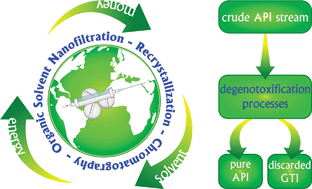Environmental and economic analysis for selection and engineering sustainable API degenotoxification processes
Abstract
The present paper discusses a comparative study concerning performance efficiency and sustainable impact of three purification processes for degenotoxification of Active Pharmaceutical Ingredients (APIs) post reaction streams: recrystallization, flash chromatography and organic solvent nanofiltration (OSN). Two case studies in each process were selected for evaluation of the separation technologies featuring the same model API being Mometasone furoate (Meta) glucocorticoid and two genotoxic impurities (GTIs). Methyl mesylate (MeMS) and 4-dimethylaminopyridine (DMAP) were chosen as model impurities due to their incidental appearance in glucocorticoids based on a common methanesulfonylation manufacturing step. Successful degenotoxification was achieved in all cases concerning DMAP and MeMS reaching final GTI levels below the regulatory thresholds with the exception of DMAP using recrystallization. API losses were 5% and 6.4% for OSN, 6.4% and 11.9% for flash chromatography and 14.9% and 16.4% for recrystallization during the removal of DMAP and MeMS, respectively. The API loss occurring during the purification processes has a significant impact on the outcome of cost analysis. Mass and carbon intensity values are highest for OSN and lowest for recrystallization, while flash chromatography has intermediate values. Although recrystallization is more time consuming, it should not be discarded without careful analysis since API loss often declines at larger scales and it generally gives the API in the desired crystallographic form. Solvent recycling has a significant impact on the sustainability of all the processes by the reduction of mass intensity by two orders of magnitude (from 400–1300 to 14–63 kg/kg-API, depending on the process) and narrowing down carbon intensity to the range of 100–200 kg-CO2/kg-API. OSN requires the use of 7 diavolumes, therefore its high performance is achieved at the cost of high solvent usage. Hence, solvent recycling also has a higher positive environmental impact on OSN.


 Please wait while we load your content...
Please wait while we load your content...